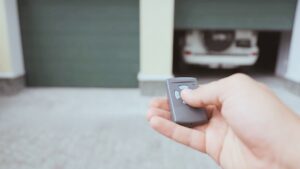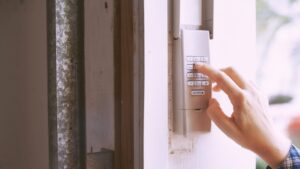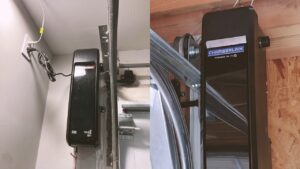Connect With A Garage Expert
Connect with local experts, Compare quotes, Get the best price.
Is your garage door stuck? A malfunctioning garage door can be a significant inconvenience and a potential safety hazard. Whether it’s jammed, making strange noises, or simply refusing to budge, dealing with a stuck garage door is a common problem for homeowners.
In this article, we will explore the various reasons why your garage door might be stuck and provide insights into how to troubleshoot and resolve the issue. From simple DIY fixes to professional solutions, we’ve got you covered to help you get your garage door back in smooth, working order.
What To Do When Your Garage Door Is Stuck?
Dealing with a jammed garage door is frustrating, but we’re here to help. Among common garage door issues, a stuck door is particularly inconvenient and can disrupt your daily routine. Here’s a detailed step-by-step guide to help when your garage door is stuck, ensuring you can address these problems efficiently and safely.
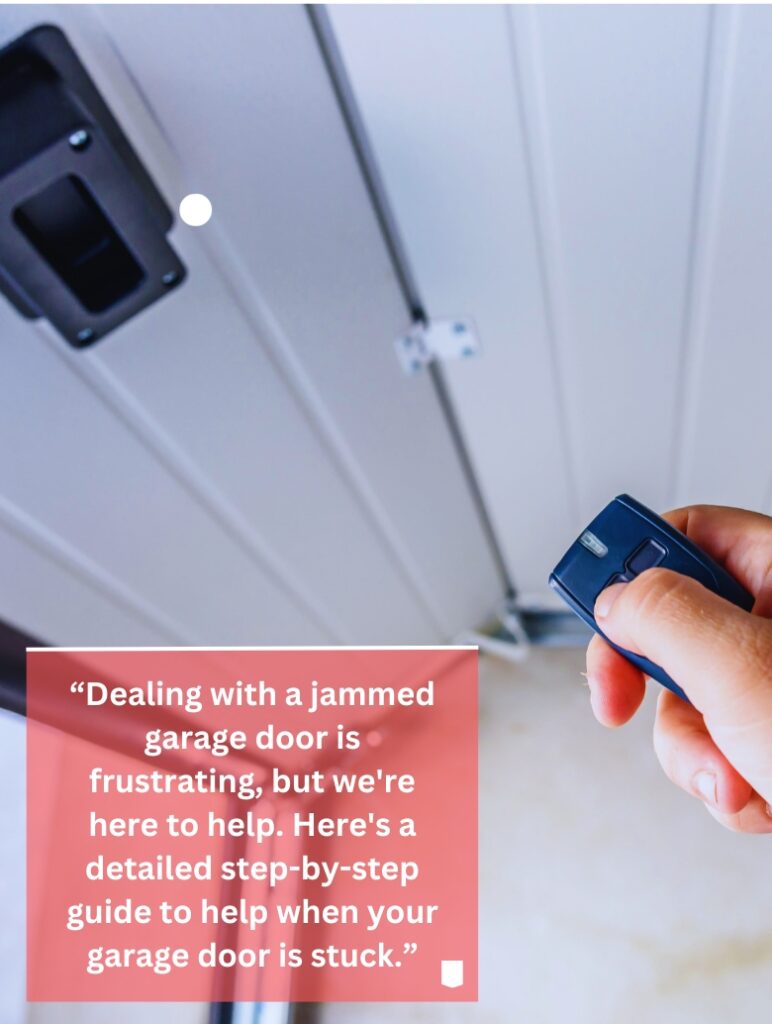
Step 1: Lubricate The Tracks
To maintain the optimal performance of your garage door, it’s crucial to keep the tracks well-lubricated. The accumulation of dirt and grime over time can lead to friction and disrupt your garage door’s smooth operation.
Regularly apply a silicone-based lubricant specifically designed for garage door tracks. This lubrication will reduce friction and allow your door to move effortlessly. By implementing this straightforward maintenance routine, you can significantly enhance your garage door’s performance and longevity.
Step 2: Check For Obstructions or Debris
Examine the area near the track mechanism and under the garage door for any obstructions or debris. Start by visually inspecting the entire track on both sides and above the door. Look closely for any debris, dirt, leaves, pebbles, or other foreign objects that may be stuck or lodged anywhere along the track.
Next, take your hand and gently run it along the entire length of the track to feel for any grit, sticky spots, or obstructions. Be very careful not to cut yourself on any sharp edges. Go slowly and methodically. See if you can dislodge smaller debris with your fingers.
Step 3: Look For Damages
Inspecting the garage door for any visible issues, such as damages or misalignments, is essential to prevent it from getting stuck. Here’s how to inspect these critical parts and what damages to watch out for:
- Hinges: Check all the hinges connecting the door panels. Look for signs of rust, cracks, or any loose bolts. Damaged hinges can impede the door’s movement, leading to noisy operation or malfunctioning.
- Cables: Examine the cables that run along the sides of the door. Look for any fraying, kinks, or visible damage. Damaged cables can compromise the door’s balance and may eventually result in it getting stuck.
- Rollers: Inspect the rollers attached to the door’s sides, which allow it to move smoothly along the tracks. Ensure they are not cracked, chipped, or misaligned. Damaged rollers can cause jerky movements and loud noises during operation.
- Brackets: Check the brackets that hold the tracks in place and support the door. Make sure they are securely fastened and not bent or damaged. Loose or damaged brackets can affect the door’s alignment and operation.
- Tracks: Examine the tracks themselves for any bends, dents, or misalignments. Even minor irregularities in the tracks can cause the door to become stuck or operate noisily.
Step 4: Check For Power Issues
To troubleshoot a non-responsive garage door opener, Inspect it first by examining potential power issues. Check the functionality of the power outlet where the opener is plugged in and ensure it’s not disconnected or damaged. Confirm that there’s no widespread power outage in your area affecting the opener.
Next, investigate your home’s circuit breaker, typically found in your electrical panel or breaker box. The exact location of the electrical panel may vary, but it’s usually located in a utility room, basement, garage, or a similar area. If you find any, reset the circuit breaker or replace the fuse to restore power to the garage door opener.
Step 5: Examine The Door’s Springs

Check the power supply to your garage door opener first when troubleshooting. Make sure the outlet is working, there are no tripped breakers, and the unit itself has power. Inspect cords for damage and try using an extension cord. If power seems fine, the issue likely lies with the opener mechanics.
Look for signs of wear, rust, or damage on torsion springs. Listen for odd noises and watch for imbalances when operating the door. For extension springs, look for overstretching. If springs appear compromised, hire a repair service to handle them. For safety reasons, leave garage door spring repairs to the professionals.
Connect With A Garage Expert
Connect with local experts, Compare quotes, Get the best price.
Six most common reasons why your garage door is jammed and how to fix it
Dealing with a jammed garage door can be frustrating, but understanding the common reasons behind the issue and their solutions can help.
Cold Climate (Weather-Related Issue)

In cold climates, your garage door may get jammed due to the contraction of metal components in lower temperatures. When metal contracts in the cold, it can cause various issues, including reduced flexibility in springs and other metal parts. This reduced flexibility can lead to stiffness, making it difficult for the garage door to operate smoothly, potentially resulting in jams or malfunctions.
Solution:
To effectively unfreeze your garage door, it’s important to use the right techniques. Applying a de-icing product to melt ice or snow that’s obstructing your garage door’s operation is essential, especially during severe winters when ice buildup can cause jams. Applying a de-icer, such as a commercial de-icer or even salt, to melt ice or snow allows you to access the lock or mechanism more easily. Utilizing items like crowbars, lock picks, or specialized lock bypass tools can make the task more manageable and restore smooth functionality.
Faulty Opener (Mechanical Issue)
A malfunctioning garage door opener can cause the door to get stuck. Issues may include a motor failure due to a damaged circuit board, broken trolley, remote control problems, or safety sensor misalignment. These problems demand prompt attention and repairs to ensure door functionality and home security.
Solution:
Inspect the opener for loose connections, damaged wiring, or worn components. Loose connections can disrupt communication, leading to operational failures, while damaged wiring affects performance. If issues are found, repair or replace the opener, and consider reprogramming or resetting it as a potential solution.
Lack of Lubricant (Maintenance Issue)
A lack of proper lubrication can cause friction, making it difficult for the garage door to move smoothly along the tracks.
Solution:
Apply a silicone-based garage door lubricant to all moving parts, including rollers, hinges, and tracks. Regular lubrication can prevent sticking and ensure your door operates without hitches.
Damaged Spring (Mechanical Issue)
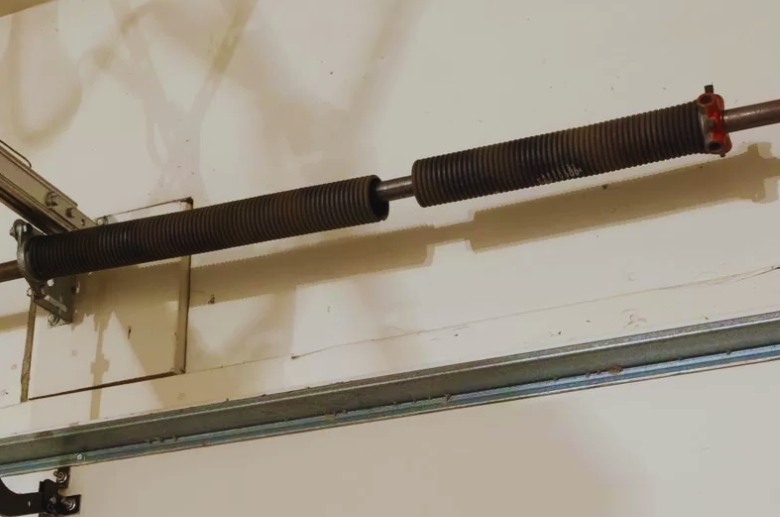
Damaged torsion or extension springs can lead to a garage door that is unbalanced and difficult to open.
Solution:
Seek professional assistance for spring replacement. Garage door springs are under high tension and can be dangerous to work on without the proper tools and knowledge.
Safety Sensor Malfunction (Safety Issue)
A safety sensor malfunction occurs when the sensors on either side of the garage door fail to detect obstructions correctly. This leads to potential safety hazards, including the garage door closing on a person or object, posing a risk of injury or property damage.
Solution:
Wipe sensors regularly with a soft cloth to remove dust and dirt buildup, and check the sensor LED lights for alignment; they should emit a steady green or blue light. Adjust alignment if needed and test door operation.
Issues With The Tracks or Rollers (Mechanical Issue)
When your garage door becomes stuck, it’s often a result of mechanical problems related to the tracks or rollers. The tracks guide the door’s movement, and if they are misaligned, bent, or obstructed, the door may not operate smoothly.
Solution:
- Bends or Damage to the Tracks: Inspect the tracks for any visible bends or damage. If you notice any, use a rubber mallet to tap them back into shape gently. Avoid force excessively, and ensure the tracks are still correctly aligned.
- Misalignment of Tracks: Tracks must be parallel and properly aligned for the door to function smoothly. If you notice misalignment, loosen the screws or bolts that hold the tracks in place and gently adjust them until they are aligned. Then, tighten the screws or bolts to secure the tracks.
- Rollers Out of Place or Damaged: Examine the rollers for any that may be out of place or damaged. If you find any issues, replace the damaged rollers and ensure the rest are seated correctly in the tracks.
How To Open Stuck Garage Door From Outside
If you find yourself in a situation where your garage door is stuck and needs to be opened from the outside, here’s a step-by-step guide to help you address the issue:
- Start by visually inspecting the area around your garage door. Look for objects, debris, or items obstructing the door’s path. Remove any visible obstacles to get the door moving.
- While attempting to open the door, listen for any unusual sounds, such as grinding or scraping. These noises can provide clues about the nature of the problem, especially when trying to open a garage door stuck halfway.
- If the door is visibly crooked or jammed on one side, this can indicate issues with the tracks or rollers. Note which side seems problematic, mainly if your garage door is stuck open.
- Most garage doors have an emergency manual release mechanism, which is especially useful when the garage door is stuck open. Locate this release cord or handle and gently pull it. This disengages the door from the opener, allowing you to operate it manually.
- With the emergency release engaged, carefully lift the garage door using the handle on the bottom. Be cautious, as garage doors can be heavy. Check if the door moves freely without resistance or unusual noises. If it’s too heavy or refuses to move, stop and assess the situation further.
- Inspect the door for loose hardware or damaged components, especially in the springs, tracks, and rollers. This step is crucial when dealing with a garage door stuck halfway.
- If your garage door operates with cables, check for any broken or frayed cables. Broken cables can hinder door movement and may need professional attention.
Can You Force Open a Garage Door?
The ability to force open a garage door varies based on factors like door type and locks. Garage doors differ in design and the approach needed to force them open. Some doors have more straightforward locks that are easier to bypass, while others require specialized tools due to more complex locking mechanisms.
The tools you have at your disposal are crucial in your ability to force open a garage door. Utilizing items like crowbars, lock picks, or specialized lock bypass tools can make the task more manageable. However, it’s essential to exercise caution and understand the potential consequences of attempting to force open a garage door.
In specific scenarios, such as emergencies or when locked out of your own garage, you may feel compelled to resort to forceful methods. In such cases, it’s advisable to balance urgency and caution. While force may be necessary, it’s still important to consult a professional or follow established procedures for such situations.
When Should You Call a Professional?
Connect With A Garage Expert
Connect with local experts, Compare quotes, Get the best price.
Knowing when to call a professional for garage door repairs is essential to ensure safety and practical solutions. Here’s why:
- DIY repairs can be risky. Garage doors are heavy and under high tension, making accidents and injuries a genuine concern. Inexperienced DIY attempts can lead to safety hazards and additional damage.
- Professionals have the experience and specialized tools required to handle complex garage door issues. They understand weight distribution, tension, and alignment, ensuring repairs are done accurately and safely.
When seeking a professional, consider the services they offer, their customer support quality, transparent fees, and their level of experience. Look for a provider with a broad range of services, excellent customer support, fair pricing, and a track record of experience to ensure a reliable and safe garage door repair.
Don’t compromise safety or risk further damage. Contact a professional for your garage door needs today, and enjoy peace of mind with expert solutions.
Final Thoughts
In essence, it’s vital to pinpoint the root cause when dealing with a jammed garage door to implement practical solutions. While minor problems can often be addressed with do-it-yourself measures, it’s paramount to exercise caution and prioritize safety. When facing intricate issues, it’s advisable to enlist the expertise of professionals.
Consistent maintenance is also strongly recommended. By maintaining a balance between awareness, safety, and preventative care, you can ensure the dependable and secure operation of your garage door. Don’t compromise safety or risk further damage. Contact a professional for your garage door needs today, and enjoy peace of mind with expert solutions.


